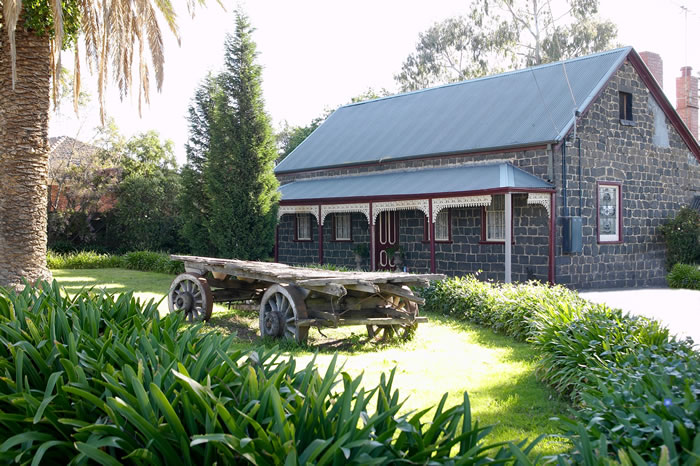Westgarthtown |

Westgarthtown is an historic dairy farming settlement sixteen kilometres north of Melbourne established in 1850 by German and Wendish immigrants.
Although now located within the residential suburbs of Thomastown and Lalor in the City of Whittlesea, many of Westgarthtown's outstanding bluestone heritage buildings and structures still survive.
These include Ziebell's Farmhouse (c.1850-51), Victoria's oldest German immigrant building; a picturesque Lutheran Cemetery (1850); and Australia's oldest operating Lutheran Church (1856).
Westgarthtown's Historic Legacy
Five orginial farmhouses and many and other historic sites remain as a stunning legacy of the early German pioneers at Westgarthtown.
Accesible to the public and forming the cornerstone of the Thomastown Pioneer Precinct are Ziebell's Farmhouse and the extensive grounds of the adjacent Lutheran Reserve, whilst other sites have been superbly preserved in private ownership.
 Ziebell's Farmhouse
Ziebell's Farmhouse Lutheran Church
Lutheran Church Lutheran Cemetery
Lutheran Cemetery Drystone Walls
Drystone Walls Graff's Farmhouse
Graff's Farmhouse Siebel's Farmhouse
Siebel's Farmhouse Maltzahn's Farmhouse
Maltzahn's Farmhouse Wuchatsch's Farmhouse
Wuchatsch's FarmhouseWestgarthtown
Ziebell's
Ziebell's original farmhouse, barn and other buildings have been been lovingly restored by the City of Whittlesea. They represent the heart of Ziebell's original 102 acre farm, named The Pines, the largest at Westgarthtown. Built between 1851 and 1856, with 61 cm thick stone walls, the house is a typical German farmhouse design. Along with the other surviving buildings - the bath house, smoke house and cart shed - the house represents a German family's hope of a new life. Remaining much as they have been for the past 150 years, the beautifully maintained gardens, provide a rich insight into the lives and interests of the people who lived there. Ziebell's farmhouse and outbuildings are all included on Victoria's Heritage Register.
Thomastown Lutheran Church
The oldest operating Lutheran church in Australia, the Thomastown Lutheran Church occupies a commanding position at the centre of the original Westgarthtown settlement's 640 acres. The deliberate placement of the building at the community's centre showed the important part religion played in the lives of the German and Wendish settlers. Dedicated on 17 November 1856, the small unnamed church, with its coursed bluestone walls, gabled iron roof, detailed bargeboards and half-round arch head windows and entry doors, was built at a cost of at least £320. The church is considered to be of state and national significance and is included on Victoria's Heritage Register. Services are conducted at 2.30pm on the fourth Sunday of each month. For more information, visit Calvary Lutheran Church.
Westgarthtown Lutheran Cemetery
Westgarthtown Lutheran Cemetery is a peaceful and remarkable place. Planted with Monterey pines along the northern, western and eastern boundaries, it is surrounded by a drystone wall. The first interment, that of an unnamed still-born child, had taken place by October 1850. Although no burial register for the cemetary survives, over 175 burials are known to have taken place. Today the cemetery remains open for the burial of decendants of those original settlers and members of the Lutheran congregation. For further information about the cemetery including a reconstructed burial list visit our cemetery minisite.
Drystone Walls
Westgarthtown's fencing was made almost entirely of stone. The drystone walls which survive at the Lutheran church reserve, most notably around the cemetery, are the last remnant of an extensive network which once bordered and divided Westgarthtown's neatly laid out dairy farms. The drystone walls on the Lutheran reserve have been restored in recent years, with the involvement of the City of Whittlesea, Parks Victoria, the Friends of Westgarthtown and Reservoir Corrections.
Graff's Farmhouse
Built in 1873, the present house is believed to be the third on the Graff family's farm. In addition to the farmhouse, a large barn, small milking shed, well, tank, several large trees, some remnant drystone walls and the ruins of an earlier house also survive. Graff's farmhouse and outbuildings are included on Victoria's Heritage Register.
Siebel's Farmhouse
This bluestone house was built for the Siebel family in 1860, replacing a smaller cottage built during the early 1850s. Siebel's farmhouse is unique amongst Westgarthtown's four other remaining houses in its more professional design and contruction and as home to the only surviving bluestone bakeoven. Siebel's farmhouse is included on Victoria's Heritage Register.
Maltzahn's Farmhouse
This bluestone house has a very interesting history. The rear of the cottage section is believed to have been built during the early 1850s and the larger front section in the 1860s.Over the course of the 20th century various changes and extensions were made to the house until the house was almost demolished in the late 1980s. Standing roofless and forlorn for over a decade, it was finally restored by Heriage Victoria in 2001.
Wuchatsch's Farmhouse
The Wuchatsch farmhouse is believed to have been built during the 1850s. It is the most complete of the surviving Westgarthtown farms, although some of the buildings have been altered over the years. In addition to the farmhouse, the original barn, milking shed and dairy also survive. The property remained in the Wuchatsch family for 166 years until sold in 2016. All buildings on the site are listed on Victoria's Heritage Register.
ZIEBELL'S FARMHOUSE: Museum & garden
Our museum and heritage garden is open every Tuesday and Sunday.
❊ Address ❊
⊜ 100 Gardenia Road, Thomastown View Map
✆ Telephone: (03) 9464 5062
❊ Web Links ❊
➼ Westgarthtown
➼ www.westgarthtown.org.au
Disclaimer: Check with the venue (web links) before making plans, travelling or buying tickets.
Accessibility: Contact the venue for accessibility information.
Update Page






